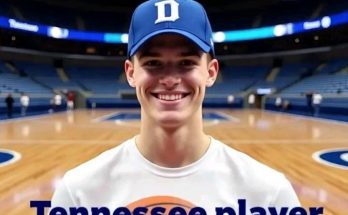Top Recruit Chooses South Carolina, Highlighting Gamecocks’ Rising Dominance in Women’s Basketball
The world of women’s college basketball was rocked once again by a major recruiting win that continues to affirm what many already know: the University of South Carolina is building a dynasty. The Gamecocks secured a commitment from Amari Johnson, the No. 1 player in the Class of 2026, a game-changing decision that speaks volumes about head coach Dawn Staley’s unshakable grip on the sport.
Johnson, a 6-foot-2 combo guard out of Chicago’s Whitney Young High School, is considered one of the most complete prospects in recent memory. She chose the Gamecocks over finalists UConn, LSU, Stanford, and Tennessee, citing a blend of player development, culture, and trust in Coach Staley’s leadership.
“This just feels like home,” Johnson said during a nationally broadcast commitment ceremony. “Coach Staley doesn’t just talk about developing young women — she shows it every single day. I want to win championships, and I want to be pushed. South Carolina is where that happens.”
A Recruiting Powerhouse
This commitment is the latest domino to fall in what has become a familiar trend for the Gamecocks. Under Dawn Staley, South Carolina has transitioned from SEC contender to national recruiting juggernaut. The Gamecocks have signed multiple No. 1 overall recruiting classes over the past decade and have now landed the top player in the nation three out of the last five years.
Johnson’s commitment marks a symbolic continuation of that trend — but with even greater implications. Unlike some of her predecessors, Johnson arrives in the NIL era, where name, image, and likeness deals play a pivotal role in college decisions. The fact that South Carolina continues to win out against programs like LSU (led by Kim Mulkey’s brash, big-spending approach) and UConn (a historic recruiting machine under Geno Auriemma) speaks to the holistic appeal of what Staley has built in Columbia.
Why Johnson Matters
Amari Johnson isn’t just another five-star name — she’s the type of player who could define a generation. With court vision reminiscent of Sue Bird, the handle of Arike Ogunbowale, and the defensive mindset of a young Tamika Catchings, she’s a rare blend of skill, athleticism, and basketball IQ.
She averaged 25.6 points, 8.2 rebounds, and 7.1 assists per game as a junior, leading her team to a 34-2 record and a state championship. Her performances on the Nike EYBL circuit and with Team USA U17 only bolstered her resume, earning comparisons to current WNBA stars before she even finishes high school.
“She’s the type of player you build a team around,” said ESPN recruiting analyst Shane Laflin. “This isn’t just a win for South Carolina. It’s a statement to the rest of the country.”
Dawn Staley’s Blueprint
The rise of South Carolina women’s basketball under Dawn Staley is one of the most compelling stories in modern college sports. Since arriving in 2008, Staley has transformed a struggling program into a perennial powerhouse. In the last 10 years alone, the Gamecocks have won three national championships, reached six Final Fours, and dominated the SEC.
But her true magic lies in the culture she has created — one that recruits like Johnson gravitate toward.
“Coach Staley makes you feel like more than just an athlete,” Johnson said. “She’s going to prepare me for the WNBA, yes, but she’s also going to prepare me for life.”
That sentiment is echoed by current and former players, many of whom remain active ambassadors for the program. A’ja Wilson, the 2018 WNBA MVP and centerpiece of South Carolina’s first title team in 2017, frequently credits Staley for shaping her career.
“You don’t just go to South Carolina to win games,” Wilson said in a recent interview. “You go there to be coached by one of the greatest ever.”
NIL Success — the South Carolina Way
In the rapidly evolving landscape of college athletics, NIL deals have become a major driver in recruiting. Programs are racing to assemble collectives, attract sponsorships, and create visibility for their players. While programs like LSU and Miami have made headlines with big-dollar offers, South Carolina has taken a more balanced approach — and it’s paying off.
Gamecock athletes have been quietly thriving in the NIL space. From partnerships with national brands like Under Armour, Gatorade, and Beats by Dre to local deals with restaurants and car dealerships, the opportunities are robust. Yet, Staley has emphasized that NIL earnings come after effort and commitment, not before.
“She’s really honest about the process,” Johnson’s father said. “She tells kids: ‘Come here, work, and the rest will come.’ That honesty resonated with us.”
Amari Johnson is expected to become one of the most marketable players in the country, especially as she steps into a program that thrives under the national spotlight. She’ll likely follow in the footsteps of former Gamecocks like Aliyah Boston, who inked endorsement deals with Adidas and Capital One while still in college.
Beating the Best
Landing Johnson required South Carolina to outduel some of the best recruiting operations in women’s hoops history.
Geno Auriemma and UConn were considered early favorites. Auriemma had been recruiting Johnson since her freshman year, and the Huskies’ tradition of excellence remains unmatched in terms of championships. Stanford made a late push, highlighting its academic prestige and Tara VanDerveer’s legacy, while Tennessee tried to sell the opportunity to revive the once-proud Lady Vols brand.
But perhaps the most intriguing battle was with LSU.
Mulkey made Johnson a priority and reportedly pitched her on an NIL package worth more than $1.5 million over four years — an offer South Carolina never tried to match. Instead, the Gamecocks pitched a winning culture, an unbreakable bond between players, and the chance to be a foundational piece in another title run.
Ultimately, that authenticity won.
“It wasn’t about the money,” Johnson said. “It was about the legacy.”
The Future is Now
Johnson’s decision will have ripple effects far beyond Columbia. She’s expected to be the centerpiece of a 2026 class that could rival South Carolina’s legendary 2019 group, which included Boston, Zia Cooke, and Brea Beal.
Several other top-25 players are now trending toward the Gamecocks, including 6-5 center Kianna Miller from California and wing prospect Riley Jacobs from Texas. Johnson’s commitment may very well set off a domino effect.
“There are players who want to compete,” Staley said. “They want to play against the best every day. That’s who we want in this program.”
With Johnson in the fold, South Carolina may be on the verge of assembling yet another super team.
A League Pipeline
South Carolina isn’t just a college basketball powerhouse — it’s a WNBA factory. Every player who starts multiple seasons for Staley has either been drafted or signed to a professional deal. And with NIL extending athletes’ college tenures, some players are arriving more prepared than ever for the professional game.
That was part of the appeal for Johnson, who already has her eye on the league.
“Coach Staley has played in the WNBA. She’s coached at every level. She knows what it takes,” Johnson said. “I don’t want to just make it. I want to be ready to dominate.”
That development pitch — rooted in both results and reputation — is difficult to match. Staley’s ability to connect with today’s players while holding them to elite standards is rare. It’s the reason players like Johnson are choosing South Carolina, even when other schools may offer more money, flashier promises, or bigger cities.
Building a Dynasty — One Brick at a Time
With the 2025-26 season approaching, South Carolina shows no signs of slowing down. The Gamecocks are once again expected to contend for a national title, and Johnson’s arrival the following year only strengthens their long-term outlook.
The freshman class already on campus includes three top-20 players, and sophomore guard MiLaysia Fulwiley is emerging as one of the most electrifying talents in the nation. Add in a mix of veteran leadership, elite coaching, and recruiting momentum, and it’s clear: the Gamecocks aren’t just winning — they’re redefining dominance.
And they’re doing it their way.
The Bigger Picture
As South Carolina builds what many are calling the “Alabama football of women’s hoops,” it’s raising the profile of the sport overall. Sellouts at Colonial Life Arena have become routine. Television ratings for South Carolina games are among the highest in the NCAA. Staley’s outspoken support for women’s empowerment, social justice, and athlete education has inspired players far beyond her roster.
The addition of Amari Johnson only adds to that narrative.
She isn’t just a great player — she’s a leader, a role model, and perhaps the future face of women’s college basketball. Her decision to join South Carolina isn’t just a win for the Gamecocks — it’s a defining moment in the sport.
As Johnson concluded her announcement, she held up a South Carolina jersey and smiled.
“We’re about to make history,” she said.
The rest of the basketball world would be wise to believe her.



